The name of this non-toxic household staple many sound odd, but I assure you it is a great natural furniture polish (and much, much more). Curious about the name? I call it wonder dressing because the ingredients are ones you might find in your favorite salad dressing (and vinaigrette is just too hard to spell on the label).
This post uses affiliate links. They don’t cost you a thing and help us bring you creative projects. Read more in Policies & Disclosures.
High Standards for Household Cleaners
Wonder Dressing could be used for salad topping (minus the essential oils) which means that it meets my safety standards. A friend pointed out the salad dressing/cleaner relationship to me after I gave her the recipe. I was delighted! Why?
I used to clean and polish my wood with commercial furniture oil until I found out that it rated F (as in FAIL) by the Environmental Working Group. I said goodbye to it as I moved toward natural, non-toxic home cleaning.
Imagine your child dropping a dinner roll on the freshly polished dining room table then pick it up to eat it without a second thought. I’d prefer that a non-toxic cleaner had been used on that table… not one full of hazardous chemicals.
Natural Furniture Cleaner and Polish Uses
Wonder Dressing can:
- Dust and protect finished wood surfaces in your home (cabinets, furniture, railings, window casings, mantels, baseboards, etc.)
- Remove fingerprints and smudges from stainless steel appliances (clean with a damp rag then lightly apply dressing and watch them disappear)
- Minimize water damage rings or spots on furniture (just apply and blast with a hair dryer)
- Dust and polish leather furniture (apply dressing sparingly to a soft cloth and wipe gently)
- Shine faucets and help them resist water spots (wipe clean with a damp rag then apply dressing)
- Remove sticky/tacky residue left by price tags on glass or plastic items (apply generously to residue and wipe clean)
- And much more… (basically I make a batch and walk around the house shining things up until it is gone)
*I recommend testing this on a small area of each item before going polish crazy.
Ingredients
I make Wonder Dressing in small batches:
- 1 Tbsp pure olive oil
- 1/2 Tbsp white vinegar (or orange vinegar)
- 1/2 Tbsp lemon juice (fresh or bottled)
- Orange or lemon essential oil (6 drops total)
Directions
- Combine ingredients a bowl or glass jar and stir until oil does not separate out (it will thicken slightly).
- Apply lightly to wood with a clean paper towel or rag. (If surface is very dirty first wipe it clean with a damp rag.)
*You can also use a spray bottle to mix and apply the polish, spray lightly (a little goes a LONG way)!
Cost
This solution costs $0.87 for 2 ounces (and 2 ounces goes a LONG way).
- Olive oil – $0.35
- Vinegar – $0.09
- Lemon juice –$0.33
- Essential Oils – $0.10
More All-Natural Wood Care Tutorials
These all natural cleaners will keep your home in tip top shape!
Like my all-natural home care tutorials? Sign up for my free newsletter below and never miss a thing!


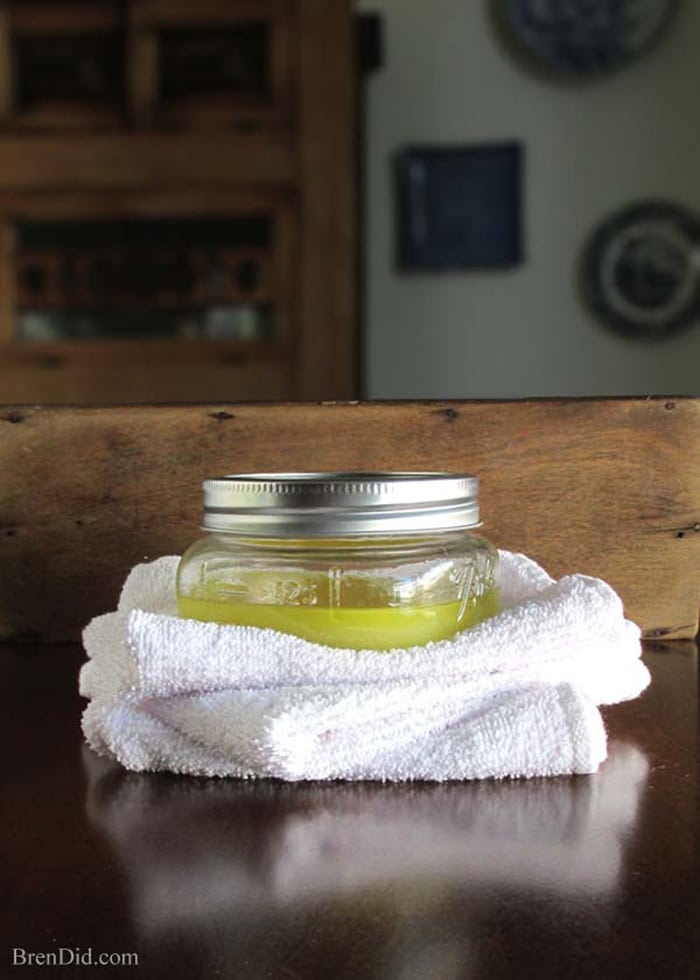
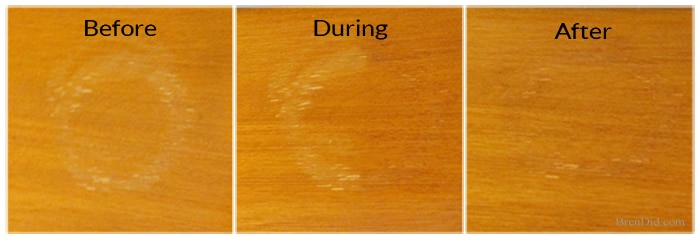
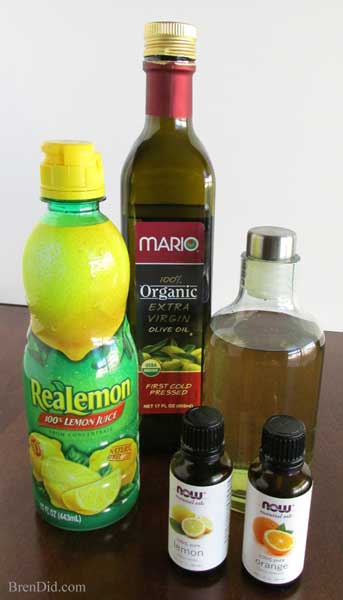
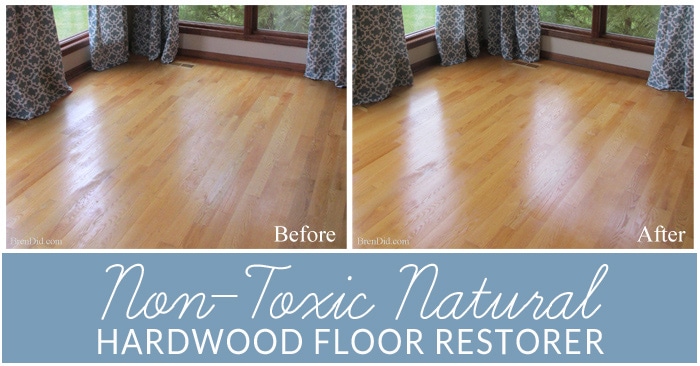
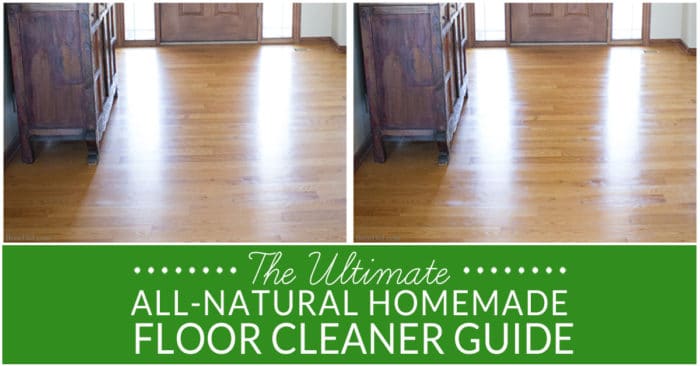

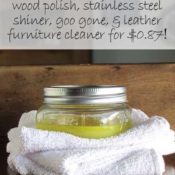
Tracy Esposito
Can I use apple cider vinegar? I am out of white vinegar.
Bren
Yes, you can use cider vinegar but it might change the smell a bit.
Cynthia Ramberg
What can I use in place of vodka? I can’t have alcohol in my household.
Bren
Hi Cynthia! You don’t need any vodka in this recipe just vinegar!
Lorraine Cappuccio
Hi,
Is it necessary to use the essential oil?
Thanks
Bren
No, you can skip them.
Kari H.
Hi there 🙂
Can this wonder dressing be used to clean stainless steel appliances?
Thanks!
Bren
I’ve successfully used it on my stainless steel trash can and appliances after they have been wiped clean.
Trisha Gawley
Hi,
Can you explain how it’s OK to use vinegar in this wood polish when the other post on uses for vinegar states not to use it on wood surfaces?
I have a beautiful midcentury dinning room table and need to find a good cleaner!
Thanks!
Bren
Trisha, I would not use vinegar to clean wood on a regular basis or on unfinished wood it can damage the surfacs. On a well finished wood surface this polish can be occasionally used to cut through grime and add shine. I would make sure the finish on your table is in good condition before trying this polish. You are the best judge of what would work for you item. Good luck!
Wood worker
Hey Trisha.. This is quite a late comment on your post but maybe it can still help. I worked for a man in restauration and he used ‘soft soap’ (I hope this is the correct translation).. It comes in those big buckets and is what all the old folks used to wash wooden floors or for cleaning in general. You add a tiny bit to warm water and depending on how sensitive the timber is, scrub accordingly.
Always make sure to dry the timber up well with a towel afterwards and don’t scrub it moist. If you do and your table happens to be soft wood you will remove all the softer growth rings, leaving your surface looking bumpy.
Good luck on the project
Cen
may i ask something?
so why should we add vinegar for the solution?
Bren
Cen, vinegar contains acetic acid which breaks down grease, germs and mold.
Cen
hey, thanks for the reply 🙂
Amy
Hello Bren. Just wondering, in all the recipes for laundry and dishwasher detergent that calls for vinegar, you mention only white vinegar or orange vinegar. Will Apple Cider Vinegar work as well?
Bren
I generally use white vinegar because it is less expensive and does not contain sentiment that apple cider vinegar sometimes contain. You can try apple cider vinegar and see how you like the results. Good luck!
Lori
Hello Bren,
What a wonderful blog-website you have! I noticed you used this on your wooden floors. Years and years ago, my husband and I rented a home that had hardwoods throughout. I was dusting the furniture and unbeknownst to me, the commercial cleaner I was using over sprayed onto the floor. The next morning when I got up, (I had socks on) one of my little ones was crying so I ran into his room, my feet flew out from under me and I went down an entire flight of steps. It literally knocked the wind out of me, let alone a HUGE bruise on my backside! Does this product leave a slippery residue? We have since purchased a home w/ hardwoods throughout and I’d love to keep up with the ‘shiny’ look but am very afraid as you probably would expect.
Thanks for the insight!
Lori
Bren
Lori, it will make the floor a bit slick… especially if it is not buffed well… so I would probably not use it on stairs. You can read more about how I clean wood floors here.
Mary
Mine will not mix , keeps separating. Any ideas?
Thanks,
Mary
Bren
It will work fine if separated, just give it a shake before using. You can try storing it in a cooler place to help it combine.
Lisa
Where do you get essential oils?
Bren
Lisa, you can buy essential oils lots of places. Just make sure they say 100% essential oil.
Jackie
Have you ever used this on leather shoes?
Bren
Interesting idea, Jackie! I have not used it on leather shoes. I have used it on leather furniture. Let me know if you try it on shoes!
Jo
Love it!! Great citrus smell too
Bren
Thanks Jo! Glad you like the recipe!
faith
Can you use lime juice instead of lemon juice?
Bren
Faith, I have never tried lime juice but this article says it works. If you try using lime juice please let me know how it works for you! 🙂
Becca
Can you store your cleaners for later use?
Bren
Becca, yes you can store the Wonder Dressing for future use. It is thicker when you first make it and thinner after it is stored but it still works great. Hope this helps!
Denise
Hi Bren
Can you use coconut oil instead of olive oil in this as well as your wood floor restore?
Bren
Good question, Denise! You should be able to use fractionated coconut oil in both recipes. I would recommend making a small batch to test it as I have never personally used it before. (Fractionated coconut oil is a liquid and does not become solid at room temperature like Virgin Coconut oil.) I generally use cheap olive oil in my cleaning products for cost savings but other natural oils should work too. Please let me know how it turns out or if you have other questions.
Denise
Thanks for replying so quickly Bren…I have Virgin Coconut Oil at home, its hot here in Jamaica and most times VCO is liquid. I will try and let you know how it works. I discovered your site today and must commend you on your work. Very informative blog! I will be launching my All Natural Skin Care line soon and would appreciate any advise you have to offer in this area. Thanks much…:-)
Rikki
Are the essential oils needed? I have everything else at home.
Bren
Rikki, the essential oils add scent but the recipe works perfectly well without them! Hope you like the recipe!